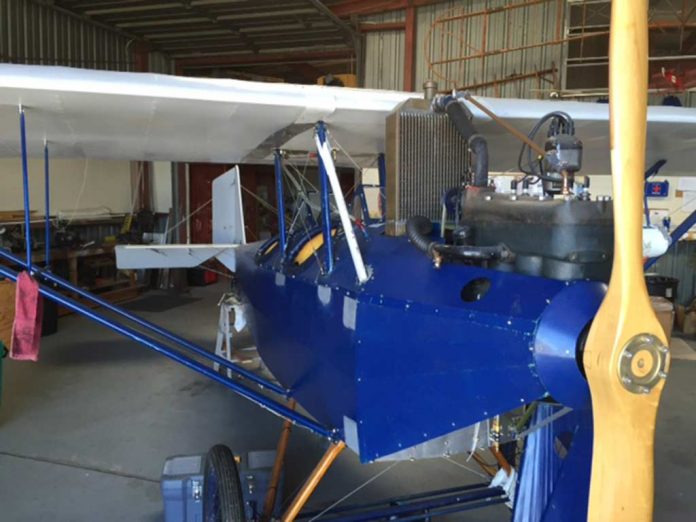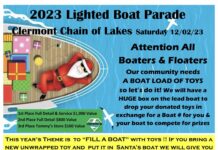Article and Photos by Ted Luebbers
As a teenager, I used to build balsa and paper model airplanes and as I got a little older, I got more involved with building and flying U- Controlled models. For some reason, I never moved into radio-controlled model aircraft. I guess this may have been about the time I discovered girls and got my first car. Not necessarily in that order.
I always had a keen interest in aviation having taken several airplane rides with family friends at an early age and made a start at getting a private pilot’s license shortly after graduating from college. About that same time, I got married and began to raise a family.
This is the same old story that happened to many would-be flyers. Family came first, so that took up the time and money which spelled the end of my aspirations to become a licensed pilot. My main hobby at this point in my life became amateur radio. It was cheaper and something I could do at home.
As time and my career as a medical representative for a large pharmaceutical company moved on, my interests gravitated to ocean sailing. Most of this along the coast of Maine as well as some chartering in the Caribbean and Florida. This lasted a couple of decades until I retired. At that point I sold the Catalina 34 sloop and RVing in various trailers and motorhomes became the thing to do.
Still, I had never lost my interest in aviation. I would buy and read books about flying, get an occasional plane ride from a friend or relative, but never started flight training again.
In 2013 my late wife of 56 years, Deborah, passed away after a lengthy illness. I was devastated and lost.
I decided what I needed was a distraction to keep me moving forward, so at age 80, I began to take flying lessons at a nearby airfield where I was living in Florida. I logged 15 hours with four different instructors and four different airplanes. At this point in life age and health caught up with me, so for my own safety and those on the ground beneath me I stopped the lessons.
I enjoyed flying very much, I should have done this at a much younger age. Now six years later as I look back on this time I should not only have started earlier in my life but moved faster in my dual instruction with fewer instructors and one airplane.
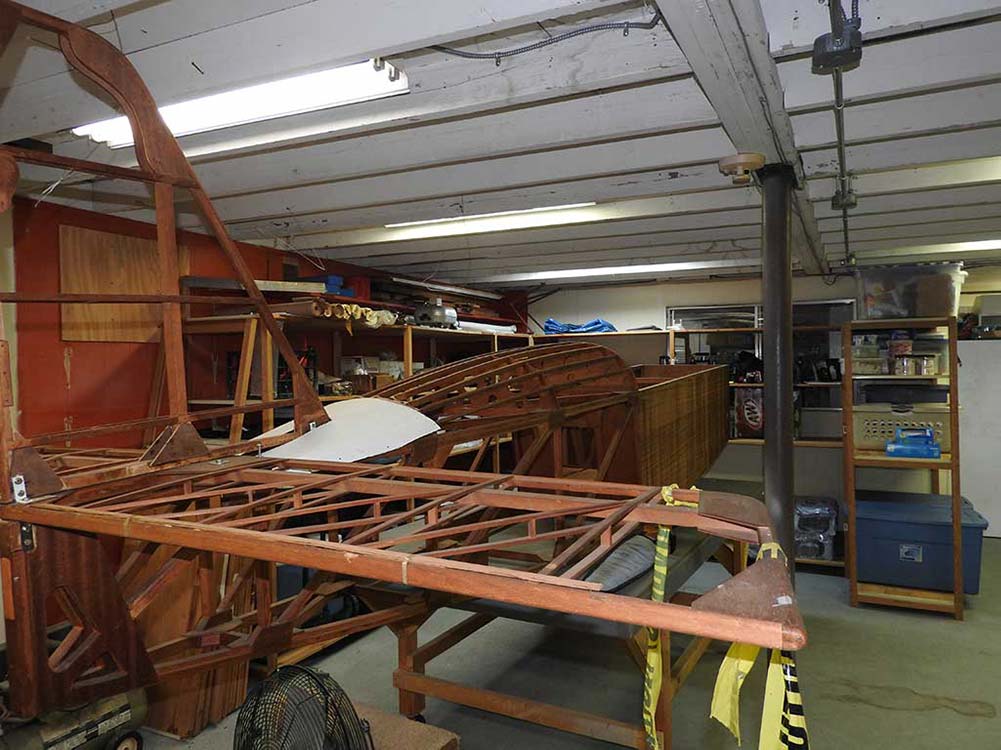
About the same time that I began my flying lessons, I also joined the Mid Florida Experimental Aircraft Association Chapter 534 at the Leesburg International Airport in Leesburg FL. I had belonged to the national EAA for several years.
Eventually, I met Joan, my trophy wife, who also has an interest in aviation and has joined the EAA chapter with me and is currently the Secretary. She is five years younger than me.
It was at the EAA Chapter 534 hangar that I guess I found my current interest in building and repairing real airplanes.
Now my teenage modeling skills could be applied to building planes on a much larger scale. All the years I had working on boats of wood and fiberglass had application as well.
At this point, I knew nothing about the Pietenpol Aircraft or Bernard Pietenpol.
I discovered a wooden fuselage languishing in the back room of the chapter hangar. There were also some tail feather parts laying around that I was told needed to be modified. It seemed that the chapter had bought somebody’s Pietenpol project a while back but nobody had much interest in working on it because there were too many other more interesting building projects going on in the front of the hangar.
The Pietenpol Air Camper is a plans-built 1929 replica of the original that Bernard Pietenpol built and flew back then. He advertised it in a copy of Mechanics Illustrated way back when, and over the years hundreds of these planes have been built in garages, dining rooms, and hangars by amateur builders. They are constructed of wood and fabric and although the originals were powered by Ford Model A engines, today many different powerplants are used.
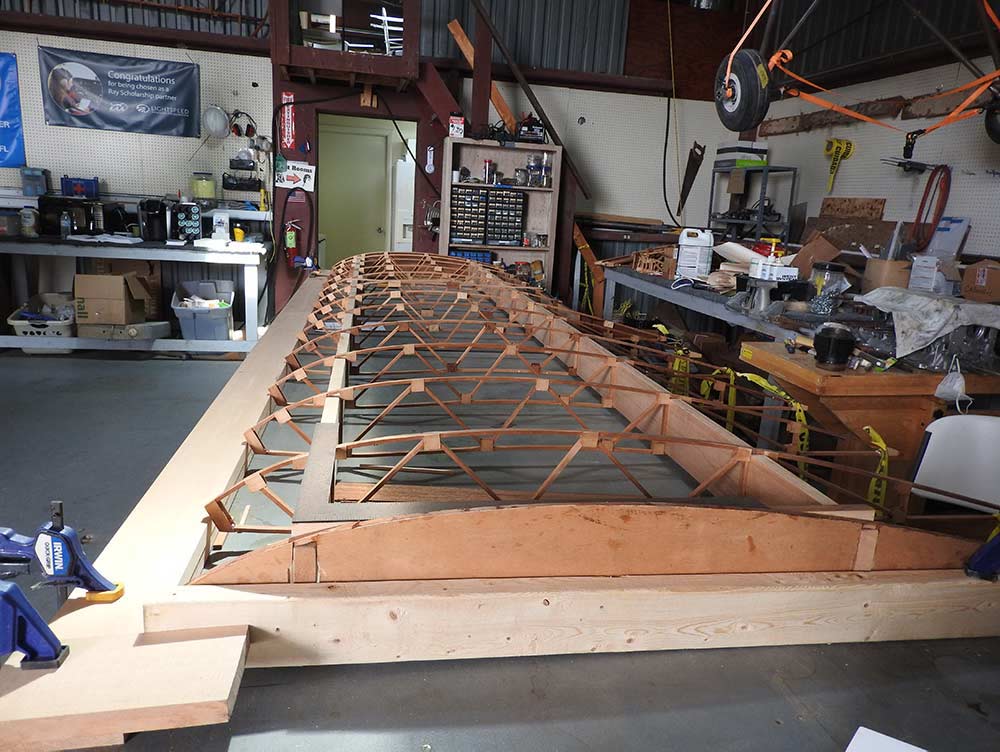
At that time, one of our members, Lou Larsen, was trying to finish his 18 year Pietenpol project with the chapter’s help and there was a Murphy Rebel being rebuilt. These were the shiny objects that captured the hangar monkeys’ interest and it seemed that the back-room Pietenpol would never make it to the front of the hangar. Hangar monkeys are how we affectionally refer to those chapter members who turn out for just about every hangar work session.
I had some basic woodworking skills and I was able to watch what was going on with Lou’s Pietenpol, so my interest in doing something with those pieces of lumber in the back room took root.
I started by working with a jig to build the wing ribs. This was labor-intensive as we only had one jig and most of the time one person to work on them. Me. A lot of woodcutting and gluing but with time all the ribs were finished.
About this time the Chapter acquired A Mini Max single-seat light-sport aircraft that had been damaged in a tornado that blew through a nearby airport. This plane’s wings and flaperons had been badly damaged and its owner had no interest in rebuilding it, so he donated the corpse to the chapter.
This is the airplane on which I learned how to put together a wood and fabric aircraft as did many of our members. During this time, I worked mostly on the Mini Max along with other hangar monkeys and learned a lot.
It took us a little more than a year to restore the Mini Max to airworthy condition, and then we sold it and applied the profit to our chapter’s youth aviation program.
Meanwhile, Lou Larsen’s Pietenpol was finished and sold to a person at Old Rhinebeck. Too bad Lou never lived long enough to see it fly. The Murphy Rebel was completed and sold also.
Suddenly there was all this space in the front of the hangar. It was time to move the back-room Air Camper to the front. We set the old fuselage up on a work table in the front room. Once people started to notice this newcomer, interest in it began.
Initially, I was the one primarily working on this aircraft. I was able to mount the vertical and horizontal stabilizer, elevator, and rudder to the fuselage. For this job, I sought the advice of our in-house Airframe and Power Plant mechanic Steve Tilford, and aircraft builder, John Weber. With the help of Lou Buffardi and Andre Nadeau we were able to install the flying wires for the tail feathers.
At times we got valuable help from the Squadron 534 youth aviation members on some of those labor-intensive jobs. For my part, I seemed to be learning right along with the kids. In order for me to do any mentoring, I had to try to stay one lesson ahead of them.
About this time Greg Nilsen joined our merry group and he brought his General Motors’ engineering skill to putting together the landing gear. The plan was to get the landing gear in place so we could get the plane off the work table. Then we could set up a 16-foot work table in that space to assemble the wings on.
Greg did a lot of metal cutting, measuring, grinding and tack welding, and John Weber, who has become the chapter’s most experienced welder, finished up the pieces.
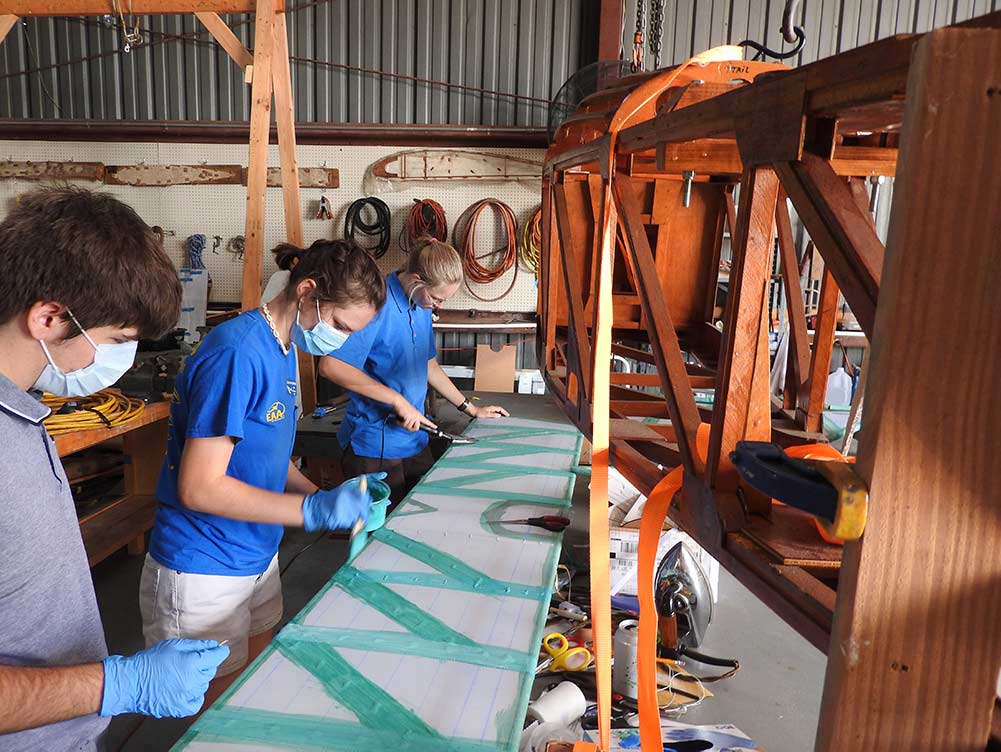
During the Covid-19 pandemic, our aviation youth program was shut down and some chapter members were concerned about gathering in groups, so work on the Pietenpol and other aircraft projects slowed down.
There was always a small core group of masked hangar monkeys who continued to work. Some members worked alone or with one other partner to avoid Covid-19 exposure. Masks were the order of the day in the hangar.
While this was going on I started investigating the possibility of using a Corvair engine for this plane. I knew we had some boxes of Corvair engine parts in the back room so I dragged them out to the front room to see what we could use for cores to put together an engine using William Wynne’s manuals. This is still a work in progress and in need of funding.
About this time John Weber suggested we paint the tail feathers. We decided on a bright yellow. We detached the flying wires and removed everything from the fuselage. He taught me how to use the HVLP spray gun and I applied three coats of latex house paint to them. They came out very well.
With the landing gear well underway it was decided to hoist the fuselage up to the ceiling of the hangar to make room to set up the 16-foot work table.
The spars for the wings had been ordered some time ago and were stored in the hangar loft. They were brought down and placed on the wing work table to begin the process of slipping the ribs on them. It was quickly discovered that the spar pass-throughs built into ribs were going to be a very tight fit. The spars were one inch wide and so were the pass-throughs.
Initial attempts to get the ribs onto the spars resulted in broken ribs. The question became should we shave off some of the spar or open the ribs up a little?
Discussions with the chapter A & P helped us decide not to touch the spars in any way but to open up the spar pass-throughs in the ribs. This took a lot of time with the use of a Dremel tool, wood rasp and sandpaper. Finally, we were able to slip the ribs easily onto the spars.
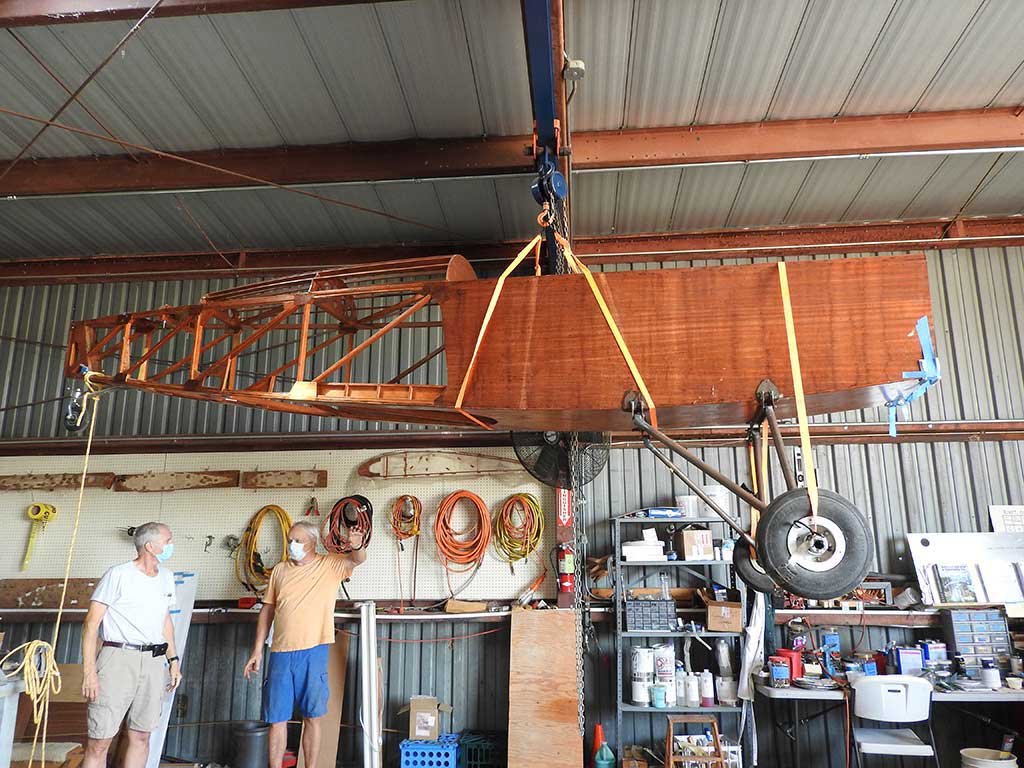
Currently, we are in the process of squaring up the wing with compression spars and drag and anti-drag wires. We are also about to attach the steel hardware necessary for attachment to the center section of the wing which would be over the cockpit. Again, Greg cut the steel and fabricated all of these with John doing the welding.
After this right-wing is completed, we will use the same table to create the left-wing in the same way. We will be very careful how we orient everything on the table to ensure that we do not accidentally create two right wings.
People keep asking me when this project will be completed. My answer is “Thursday”, but I never say what year.
The way things are going now we estimate the Air Camper will be finished in a couple of years if we can get the funding we need for This project has been a great learning experience f or all of our members young and old. When it is completed and flight tested, we plan to sell it and put whatever money we make on it back into the chapter’s youth aviation program.
All photos taken by Ted Luebbers and permission granted to use any or all. More photos available on request.



